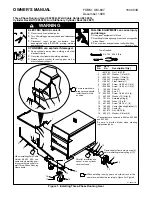
Kunststoffschweißtechnik
Starting and operating
Chapter 5
14.02.2012
Working instructions WIDOS 2500 - 250 adjustable
Page 19 of 48
5.3. Welding process
T h e r e s p e c t i v e l y v a l i d w e l d i n g p r e s c r i p t i o n s ( I S O / C E N / D V S . . . ) a r e
t o b e b a s i c a l l y f o l l o w e d .
•
Wear safety gloves as protection against combustion!
•
A stop-watch must be available for recording the actual times for heating and cooling.
•
A welding table must be available from which the parameters for the pipe dimensions to be
welded prescribed by the welding prescriptions may be taken.
•
The heating element surfaces are to be clean and, above all, free from grease.
Therefore they are to be cleaned with non-fraying paper and detergent (e.g. PE cleaner)
before every welding or if they are dirty.
The anti-stick coating of the heating element is to be undamaged in the working area.
•
Switch on the heating element (chapter: 5.2.4) and set the necessary welding temperature
(The value for PE 80 is between 210°C / 410°F
).
-
If the nominal temperature has been reached, it will be maintained by means of a defined
pulse-pause ratio.
5.3.1. How to insert and clamp the pipes
•
Mount the reduction inserts according to the pipe outside diameter to be welded and the
respective pipe support.
•
Place the work pieces in the clamping devices, tighten firmly the clamping nuts and align
the pipes with respect to each other.
•
Either adjust the pipe supports onto the outer diameter of the pipe (chapter: 5.2.5).
•
Or place the pipe supports onto the pipe brackets according to the outer diameter of the
pipe (chapter: 5.2.6).
•
Place the workpieces into the clamping devices with the same overhang, shut the clamping
rings, align the workpieces to each other and tighten the clamping nuts.
•
Use WIDOS rollerstands in order to align long pipe ends.
5.3.2. How to plane the pipes
Noise exceeding 80 dB (A) may occur; during planing it is obligatory to wear
ear protection!
•
Swivel the planer between the ends of the workpieces.
•
Activate the switch (chapter: 4.2, no. 10) at the planer and lock it by the locking button (12).
•
In order to plane, keep button (no. 11) pressed.
•
Drive the pipes ends towards the planer by the turnstile.
•
Cut the pipes ends even by slight contact pressure. Keep planing until a revolving chip (2-3
times) has formed.
•
Drive the workpieces apart again, release the button (11), switch the planer off and swivel it
to the rear.
•
Remove produced cuttings without touching the worked surfaces.
















































